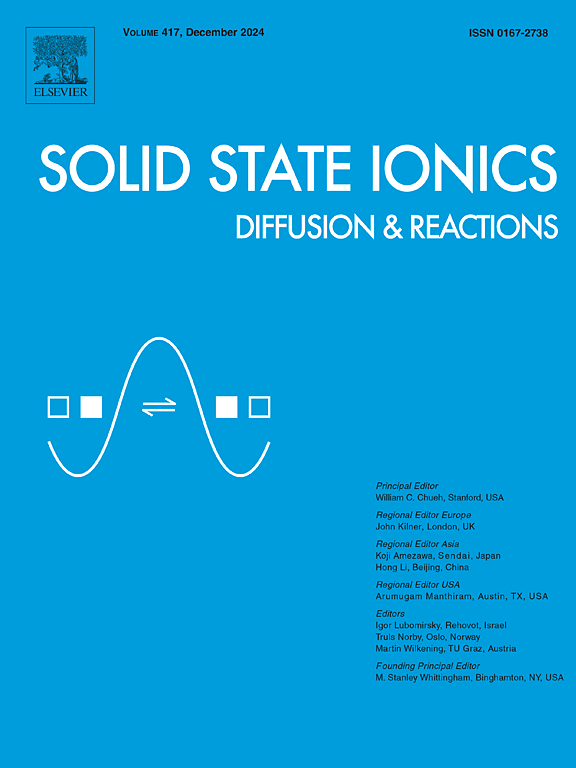A first-principles research of two-dimensional Sc2N monolayer as an anode material for Na, K, Mg, and Ca ion batteries
IF 3
4区 材料科学
Q3 CHEMISTRY, PHYSICAL
引用次数: 0
Abstract
With the continuous growth in global energy demand and the challenges posed by the intermittent nature of renewable energy, the development of efficient energy storage systems has become increasingly critical. This has spurred significant interest in non‑lithium metal-ion batteries and their high-performance anode materials. Based on first-principles calculations, this study systematically investigates the potential of Sc2N monolayers as anode materials for Na, K, Mg, and Ca ion batteries. The results demonstrate that Sc2N monolayers exhibit excellent mechanical, thermodynamic, and kinetic stability, along with outstanding electrical conductivity, making them good candidates for the next-generation anode materials. The theoretical capacities and open-circuit voltages of Sc2N monolayers for metal ions are as follows: Na (1547.4 mAh/g, 0.321 V), K (343.9 mAh/g, 0.401 V), Mg (2063.2 mAh/g, 0.211 V), and Ca (458.5 mAh/g, 0.292 V). Sc2N monolayers also exhibit low ion diffusion barriers of 10.1, 9.7, 32.3, and 38.3 meV for Na, K, Mg, and Ca, respectively. Ab Initio molecular dynamics (AIMD) simulations conducted at 300, 500, and 700 K under fully loaded Na and Mg conditions further confirm the excellent thermal stability of Sc2N monolayers. Therefore, Sc2N monolayers demonstrate high theoretical capacities, low diffusion barriers, and ideal open-circuit voltages for Na and Mg ion batteries, with superior safety features, underscoring their significant potential for applications in energy storage technologies.
二维Sc2N单层作为Na, K, Mg, Ca离子电池负极材料的第一性原理研究
随着全球能源需求的持续增长和可再生能源间歇性带来的挑战,开发高效的储能系统变得越来越重要。这激发了人们对非锂金属离子电池及其高性能负极材料的极大兴趣。基于第一性原理计算,本研究系统地研究了Sc2N单层作为Na, K, Mg和Ca离子电池负极材料的潜力。结果表明,Sc2N单层具有优异的机械、热力学和动力学稳定性,以及出色的导电性,使其成为下一代阳极材料的良好候选者。Sc2N单层膜对金属离子的理论容量和开路电压分别为:Na (1547.4 mAh/g, 0.321 V)、K (343.9 mAh/g, 0.401 V)、Mg (2063.2 mAh/g, 0.211 V)和Ca (458.5 mAh/g, 0.292 V)。此外,Sc2N单层膜对Na、K、Mg和Ca具有较低的离子扩散垒,分别为10.1、9.7、32.3和38.3 meV。在满载Na和Mg条件下,在300、500和700 K下进行了从头算分子动力学(AIMD)模拟,进一步证实了Sc2N单层膜优异的热稳定性。因此,Sc2N单层具有较高的理论容量、较低的扩散障碍和理想的开路电压,可用于钠离子和镁离子电池,并具有优越的安全性,强调了其在储能技术中的巨大应用潜力。
本文章由计算机程序翻译,如有差异,请以英文原文为准。
求助全文
约1分钟内获得全文
求助全文
来源期刊

Solid State Ionics
物理-物理:凝聚态物理
CiteScore
6.10
自引率
3.10%
发文量
152
审稿时长
58 days
期刊介绍:
This interdisciplinary journal is devoted to the physics, chemistry and materials science of diffusion, mass transport, and reactivity of solids. The major part of each issue is devoted to articles on:
(i) physics and chemistry of defects in solids;
(ii) reactions in and on solids, e.g. intercalation, corrosion, oxidation, sintering;
(iii) ion transport measurements, mechanisms and theory;
(iv) solid state electrochemistry;
(v) ionically-electronically mixed conducting solids.
Related technological applications are also included, provided their characteristics are interpreted in terms of the basic solid state properties.
Review papers and relevant symposium proceedings are welcome.
 求助内容:
求助内容: 应助结果提醒方式:
应助结果提醒方式:


